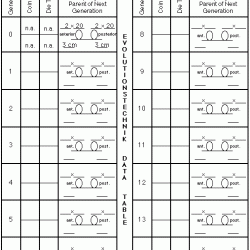Source Institutions
Source Institutions
Add to list Go to activity
Activity link broken? See if it's at the internet archive

In order to examine the random nature of mutations and natural selection, learners "breed" clutches of Egyptian Origami Birds (Avis papyrus) using random number generators (dice and coins) to mutate several genetic loci: anterior and posterior wing position, wing width, and wing length. The birds are then "released." Only those birds which can fly the furthest survive to produce offspring. After several generations, learners usually note a significant increase in flight distance and duration. In a second experiment, different groups of learners study separate sub-populations of Egyptian Origami Birds, which experience different selection pressures. Details of Origami Bird anatomy, breeding and selection, are in the learner instructions and associated graphic.
- 10 to 30 minutes
- 2 to 4 hours
- $5 - $10 per group of students
- Ages 14 - 18
- Activity, Lesson/Lesson Plan, Simulation
- English
Quick Guide
Materials List (per group of students)
- Instructions
- Paper
- Tape (clear or masking)
- Straws (non-bending are best)
- Six-sided die
- Copper or other metal
- Binary random number generator (i.e. a penny)
Subjects
-
Life Sciences
-
Diversity of Life
- Animals
-
Ecology
- Biodiversity
-
Evolution
- Evidence for Evolution
- Mechanisms of Evolution
-
Heredity and Genetics
- Patterns of Heredity
-
Diversity of Life
-
Mathematics
-
Data Analysis and Probability
- Data Analysis
- Data Collection
-
Measurement
- Size and Scale
- Circles
-
Data Analysis and Probability
-
The Nature of Science
-
The Scientific Process
- Conducting Investigations
- Gathering Data
- Formulating Explanations
- Communicating Results
-
The Scientific Process
Informal Categories
- Animals
- Arts and Crafts
- Nature and Environment
Audience
To use this activity, learners need to:
- see
- read
- be mobile
- touch
Learning styles supported:
- Involves teamwork and communication skills
- Involves hands-on or lab activities
Other
Components that are part of this resource:
This resource is part of:
Access Rights:
- Free access
By:
- Westerling, Karin
Rights:
- All rights reserved, Access Excellence @ the National Health Museum, 2009
